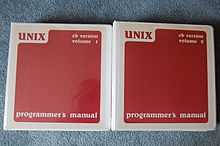CB UNIX
| Unixes by Bell |
|---|
| Research Unix |
| Other |
|
Columbus UNIX, or CB UNIX, was a variant of the UNIX operating system used internally at Bell Labs[1] for administrative databases and transaction processing.[2] It was developed at the Columbus, Ohio branch, based on Unix V6, V7 and PWB.[3] It was little-known outside the company.
CB UNIX was developed to address deficiencies inherent in Research Unix, notably the lack of interprocess communication (IPC) and file locking, considered essential for a database management system. Several Bell System operation support system products were based on CB UNIX such as Switching Control Center System. The primary innovations were power-fail restart, line disciplines, terminal types, and IPC features.[4]

The interprocess communication features developed for CB UNIX were message queues, semaphores and shared memory support. These eventually appeared in mainstream Unix systems starting with System V in 1983, and are now collectively known as System V IPC.[2]
References
- ↑ Rochkind, Marc (1985). Advanced UNIX Programming. Prentice Hall. pp. 156–157. ISBN 0-13-011800-1.
- ↑ 2.0 2.1 Kerrisk, Michael (2010). The Linux Programming Interface. No Starch Press. p. 921.
- ↑ J. D. Doan, ed. (May 1981). CB-UNIX Programmer's Manual, Edition 2.3 (PDF). Columbus, OH: Bell Telephone Laboratories. p. iii.
- ↑ Dale Dejager (1984-01-16). "UNIX history". Newsgroup: net.unix.